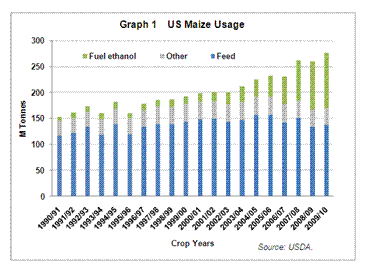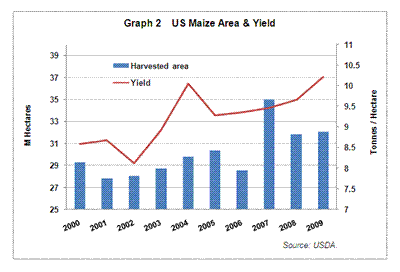
US Maize and Ethanol
- Tuesday December 8, 2009
This analysis featured in the December 8, 2009 issue of the HGCA's MI Prospects, Volume 12, Issue 12
Key Points
The US maize supply situation is expected to remain relatively tight for some time with expanding demand particularly for fuel ethanol production helping absorb some large crops in recent years.
US maize has not lost much of its ascendancy in the international marketplace, as have US wheat and soyabeans. This year's US maize harvest is currently estimated at 328.2Mt, more than 40% of world maize production and more than 30 % of world coarse grain production. Last year's 47.2Mt maize exports were almost 60 % of world trade in maize and 43% of world coarse grain trade.
Even though the structure of the world feedgrain market has not changed much, the dimensions of the internal US market have and this has the potential to impact on the international trade in the not too distant future.
US consumption of maize for ethanol production since 2001 has increased by a multiple of more than six and at an annual average compounded rate of almost 25% (Graph 1). During 2009/10 US maize consumption for ethanol production is projected to reach 106.7Mt which is double the projected US net-exports of maize for the crop year. It exceeds US consumption of all grain for food products and is more than three-quarters of US livestock feed consumption which traditionally was the dominant use for maize (Table 1).
continue

As striking as this growth in use has been, more remarkable has been the growth in US production to enable this to occur without undue supply pressures elsewhere. Increased output has been achieved initially through increased area, but more recently through higher maize yields which have been recorded despite less than ideal weather conditions (Graph 2).
continue
Shorter Term Prospects
Although harvest is late this year and yet to be completed, record yields together with an above average area are currently expected to result in an output of 328.2Mt. This would be 7% above last year and only slightly below the record crop of 2007. Based on this projection, the USDA is forecasting a 14% increase in ethanol use, a 3% increase in feeding and a 13% increase in exports, leaving ending stocks 3% lower. Some weakening of export demand, probably the result of competitive feed wheat values on international markets has been seen. But general price levels are expected to be somewhat higher this year than last to achieve a relatively minor need to ration.
The supply situation has at times appeared threatened by the delayed maturity of the maize crop and more recently the late harvest. This threat appears to have passed in the context of material losses which would have resulted in much enhanced maize prices.
As has been the case for several years, concern about relationships between maize and soyabean prices with regard to sowings in spring continues. Hence, any significant increase in soyabean prices will result in higher maize values.
Longer Term Prospects
Longer term maize market prospects are tied closely to those for grain produced fuel ethanol. The growth in US consumption of grain for fuel ethanol production has particularly been driven by political agendas rather than direct economics. The 1980s and 1990s saw steady but not spectacular growth in US ethanol productions as rural development programmes were limited and environmental and conservation justification for grain based fuel ethanol blending were uncertain.
Together with the strengthening of environmental and conservation justification has been a fuel self-sufficiency objective which first received prominence in former US President George Bush's January 2007 State of the Union Address. Later that year, it was enshrined in the US Energy Independence and Security Act.
This legislation includes rising mandates for renewable energy with financial penalties for petroleum refiners if they are not met. Generally, the politically supported economic environment has been such that targets so far have been met but this was in question during a restructuring of the industry involving several bankruptcies in 2008. Earlier the concept of using maize for fuel ethanol production looked as though it may be subject to serious political challenge in the context of rising food prices. In both instances concerns faded with the prospect of an abundant maize crop and moderating maize prices.
The 2009 USDA 10-year Baseline projection was based on conditions and existing government programmes at this time last year. It includes allowance for issues such as improved productivity and the relationship between maize and soyabean markets. It makes allowance for about 2.5% annual growth in maize usage for ethanol production, which is slower than in recent years but meeting mandates. About 1.5% is allowed for export growth and just 1% for growth in feed use.
To balance this growth in consumption, yield increases of two bushels per acre per year, about 1t/ha more than eight years ago are required. This year's yield of 162.9 bushels per acre is five bushels above the trend line level used in the projection. While this may appear to be a rather modest 10-year output objective, technology adoption has benefited from a doubling of prices in just a few years, something which is not expected to be repeated.
Furthermore, projected ending stocks were to take the full ten years to build from a rather meagre 25Mt to a more comfortable 40Mt. And while an above average crop is expected to result in more comfortable ending stocks this year, an equally below average crop would have necessitated severe price rationing. Very volatile weather markets are expected to continue for some years as the market will attempt to discount a drought or other yield reducing event.
The renewable energy lobby concerned about either surplus production capacity and / or the opportunity to add to capacity made an application to the Environmental Protection Agency last spring for an increase in the mandated level of blending of ethanol in gasoline from 10 to 15%. By delaying the decision until mid-2010, the Obama administration recently indicated it was not dismissive of the proposition. Lined up for and against it are maize producers and consumers, rural developers, environmentalists, car makers and petroleum refiners, surely requiring some sort of compromise which may add something to longer term maize demand prospects.
David Walker (001) 780 434 7615
top of page